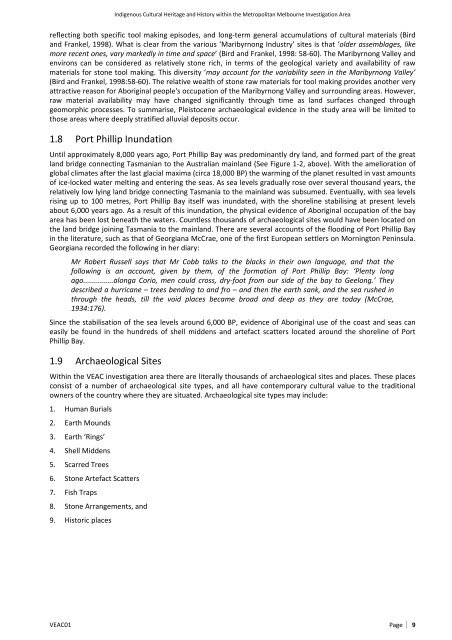Indigenous Cultural Heritage and History within the Metropolitan ...
Indigenous Cultural Heritage and History within the Metropolitan ...
Indigenous Cultural Heritage and History within the Metropolitan ...
Create successful ePaper yourself
Turn your PDF publications into a flip-book with our unique Google optimized e-Paper software.
<strong>Indigenous</strong> <strong>Cultural</strong> <strong>Heritage</strong> <strong>and</strong> <strong>History</strong> <strong>within</strong> <strong>the</strong> <strong>Metropolitan</strong> Melbourne Investigation Area<br />
reflecting both specific tool making episodes, <strong>and</strong> long‐term general accumulations of cultural materials (Bird<br />
<strong>and</strong> Frankel, 1998). What is clear from <strong>the</strong> various ‘Maribyrnong Industry’ sites is that ‘older assemblages, like<br />
more recent ones, vary markedly in time <strong>and</strong> space’ (Bird <strong>and</strong> Frankel, 1998: 58‐60). The Maribyrnong Valley <strong>and</strong><br />
environs can be considered as relatively stone rich, in terms of <strong>the</strong> geological variety <strong>and</strong> availability of raw<br />
materials for stone tool making. This diversity ‘may account for <strong>the</strong> variability seen in <strong>the</strong> Maribyrnong Valley’<br />
(Bird <strong>and</strong> Frankel, 1998:58‐60). The relative wealth of stone raw materials for tool making provides ano<strong>the</strong>r very<br />
attractive reason for Aboriginal people's occupation of <strong>the</strong> Maribyrnong Valley <strong>and</strong> surrounding areas. However,<br />
raw material availability may have changed significantly through time as l<strong>and</strong> surfaces changed through<br />
geomorphic processes. To summarise, Pleistocene archaeological evidence in <strong>the</strong> study area will be limited to<br />
those areas where deeply stratified alluvial deposits occur.<br />
1.8 Port Phillip Inundation<br />
Until approximately 8,000 years ago, Port Phillip Bay was predominantly dry l<strong>and</strong>, <strong>and</strong> formed part of <strong>the</strong> great<br />
l<strong>and</strong> bridge connecting Tasmanian to <strong>the</strong> Australian mainl<strong>and</strong> (See Figure 1‐2, above). With <strong>the</strong> amelioration of<br />
global climates after <strong>the</strong> last glacial maxima (circa 18,000 BP) <strong>the</strong> warming of <strong>the</strong> planet resulted in vast amounts<br />
of ice‐locked water melting <strong>and</strong> entering <strong>the</strong> seas. As sea levels gradually rose over several thous<strong>and</strong> years, <strong>the</strong><br />
relatively low lying l<strong>and</strong> bridge connecting Tasmania to <strong>the</strong> mainl<strong>and</strong> was subsumed. Eventually, with sea levels<br />
rising up to 100 metres, Port Phillip Bay itself was inundated, with <strong>the</strong> shoreline stabilising at present levels<br />
about 6,000 years ago. As a result of this inundation, <strong>the</strong> physical evidence of Aboriginal occupation of <strong>the</strong> bay<br />
area has been lost beneath <strong>the</strong> waters. Countless thous<strong>and</strong>s of archaeological sites would have been located on<br />
<strong>the</strong> l<strong>and</strong> bridge joining Tasmania to <strong>the</strong> mainl<strong>and</strong>. There are several accounts of <strong>the</strong> flooding of Port Phillip Bay<br />
in <strong>the</strong> literature, such as that of Georgiana McCrae, one of <strong>the</strong> first European settlers on Mornington Peninsula.<br />
Georgiana recorded <strong>the</strong> following in her diary:<br />
Mr Robert Russell says that Mr Cobb talks to <strong>the</strong> blacks in <strong>the</strong>ir own language, <strong>and</strong> that <strong>the</strong><br />
following is an account, given by <strong>the</strong>m, of <strong>the</strong> formation of Port Phillip Bay: ‘Plenty long<br />
ago...............alonga Corio, men could cross, dry‐foot from our side of <strong>the</strong> bay to Geelong.’ They<br />
described a hurricane – trees bending to <strong>and</strong> fro – <strong>and</strong> <strong>the</strong>n <strong>the</strong> earth sank, <strong>and</strong> <strong>the</strong> sea rushed in<br />
through <strong>the</strong> heads, till <strong>the</strong> void places became broad <strong>and</strong> deep as <strong>the</strong>y are today (McCrae,<br />
1934:176).<br />
Since <strong>the</strong> stabilisation of <strong>the</strong> sea levels around 6,000 BP, evidence of Aboriginal use of <strong>the</strong> coast <strong>and</strong> seas can<br />
easily be found in <strong>the</strong> hundreds of shell middens <strong>and</strong> artefact scatters located around <strong>the</strong> shoreline of Port<br />
Phillip Bay.<br />
1.9 Archaeological Sites<br />
Within <strong>the</strong> VEAC investigation area <strong>the</strong>re are literally thous<strong>and</strong>s of archaeological sites <strong>and</strong> places. These places<br />
consist of a number of archaeological site types, <strong>and</strong> all have contemporary cultural value to <strong>the</strong> traditional<br />
owners of <strong>the</strong> country where <strong>the</strong>y are situated. Archaeological site types may include:<br />
1. Human Burials<br />
2. Earth Mounds<br />
3. Earth ‘Rings’<br />
4. Shell Middens<br />
5. Scarred Trees<br />
6. Stone Artefact Scatters<br />
7. Fish Traps<br />
8. Stone Arrangements, <strong>and</strong><br />
9. Historic places<br />
VEAC01<br />
Page | 9
















